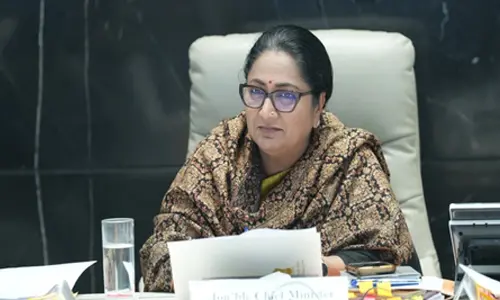Khadi–The thread of emotions

Khadi–The thread of emotions
Khadi which played a vital role in providing the ultimate source of energy for the upliftment of the weakest and marginalized sections of India is the thread of emotions even today.
Khadi which played a vital role in providing the ultimate source of energy for the upliftment of the weakest and marginalized sections of India is the thread of emotions even today. During 1918 Mahatma Gandhi put the spotlight on Khadi and although handspun textiles are still available in some parts of India, with technological advancement we now have 'solar-vastra', by Greenwear who has positioned itself for.
The company is closely working with its community partner -- 'Bhartiya Harit Khadi Gramodaya Sansthan,' an organization that implemented the pilot project for the Mission Solar Charkha, launched in June 2018, and the Khadi and Village Industries Commission (KVIC).
Abhishek Pathak, founder and CEO, Greenwear Fashion Pvt. Ltd, who aspires to penetrate into new market segments talks about solar Khadi and its contribution to the Khadi movement.
Khadi Day pays homage to Mahatma Gandhi's vision for the Khadi movement. How have Bapu's ideals inspired you as an entrepreneur?
From a broader perspective, Khadi was a social venture designed to utilise India's rural workforce and local resources, which soon became a symbol of liberation, not just from the exploitative colonialism, but also from the market-driven techno-capitalism. In Bapu's own words, Khadi wasn't a piece of cloth but an ideology. Bapu was against the de-humanizing aspect of machinery but he always encouraged technical interventions and was constantly looking for ways to make 'charkha' even better and more useful. Gandhiji offered his ashram as a place to implement various improvements in the charkhas and allied activities. The symbolic 'Kisan Charkha' or 'Sudarshan Charkha' was improved to 'Peti Charkha' (or Box Charkha) to achieve portability. Unfortunately, for so many years after independence, Khadi got trapped in its material format and could never live to fulfil its own ideological destination.
I got more inspired by the 'concept of Khadi' rather than the 'brand Khadi'. Charkha, in Bapu's vision, was a symbol of self-respect, self-reliance and economic self-sufficiency. While working to establish a Khadi institution back in 2016, I realized that in the current scenario, the vision of the Khadi movement cannot be achieved through the manual charkhas. However, with little technical intervention, Solar-Charkha (compact new model charkha/ring frame powered by solar) can definitely become a tool to improve the socio-economic structure of rural India. It was back then I started working to understand the Solar Charkha value chain and planning to establish a backward linkage through community engagement and capacity building.
With a wide range of fabrics available today, what is the appeal of Khadi which inclined you towards starting a venture around it?
More than fashion, it was the functional appeal of Khadi I got inclined towards. The breathability and absorbency due to anticlockwise-softly-twisted yarns, the comfort due to natural fibres, the uniqueness due to the handcrafted process and the feeling of authenticity fascinated me to the core. Being a textile designer, I think it comes by default to focus more on the fabric than fashion. Since my college days, I was super fascinated by traditional textiles and crafts but it was more towards its attention to details, intricacy and uniqueness. Later, when I started understanding Khadi as a product and process, I was amazed by its potential impact on both producers and the market.
What is the potential of Khadi in uplifting the rural economy and in enabling Atmanirbhar Bharat?
Khadi is one of the most powerful tools for uplifting the rural economy -- if production and consumption both can be managed locally. To begin with, If only 5 per cent of Indian villages become solar charkha clusters (around 30,000), it can produce 180 crore kilogram of cotton yarn -- which is nearly 50 per cent of India's current cotton yarn capacity -- and also generate livelihood for 1.2 crore rural Indians without migrating from their villages. But the sustainable impact will come with certain government-level interventions to provide a regular market for this much production. Many state governments provide free uniforms to their primary and senior secondary school-going students. Such procurements can be done locally by involving the solar-vastra value chain. This will further promote the use of Khadi among the masses and generate livelihood opportunities at the local level, thereby adding value to the vision of 'Atmanirbhar Bharat'.
Why and how is Greenwear supporting the Solar Charkha Mission of the Indian government?
The Solar Charkha Mission was launched by President of India in June 2018 and The Khadi and Village Industries Commission (KVIC) is implementing this program. The government of India accorded approval to set up 50 solar charkha clusters with a budget of Rs 550 crore for 2018-19 and 2019-20. The scheme is envisaged to generate direct employment of nearly one lakh persons in these 50 clusters. Currently, we are the only brand dedicated to developing the market for products made through the solar charkha value chain.
We procure yarns from Bhartiya Harit Khadi Gramodaya Sansthan (BHKGS) and creates a further value chain of fabrics and garments. BHKGS has successfully run the pilot project for Solar Charkha Mission and now gearing up to provide knowledge support to 50 other solar charkha training-cum-production centres (TPC). These TPCs will strengthen backward linkage for us. Although the price of yarns procured from BHKGS is marginally higher than a mill-made yarns, but the quality of Khadi (S-twisted yarn which mills don't produce) makes it exclusive and worth its cost. Also, the direct impact on rural women beneficiaries who are running solar charkhas at their households ensures authentic sourcing. The fabrics made of these yarns are then sold to the brand 'W for Women' without further processing which generates 80 per cent of revenue for us as of now.
What are your short-term and long-term growth plans in the times to come?
We have a mission to create 5,000 jobs for women in rural India by 2025. The jobholders we have engaged currently have valued the income and informed that the flexibility in working hours allows them to manage household obligations. Our observation indicates a reasonable likelihood that they were just above the extreme poverty line before getting engaged with solar charkha spinning and allied activities.
With the support of the Powering Livelihood programme -- jointly run by Villgro Innovations Foundation and CEEW -- We have been streamlining its business activities while sailing through the most stressful times of Covid-19. Further, Greenwear was also able to engage 240 women SHG members in mask manufacturing at household levels during the Covid lockdown period. The Powering Livelihoods programme helped Greenwear to onboard new institutional partners as well, thereby accelerating our future growth prospects.














